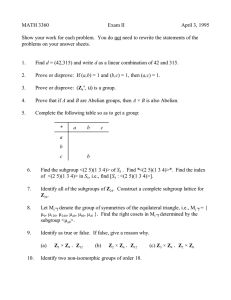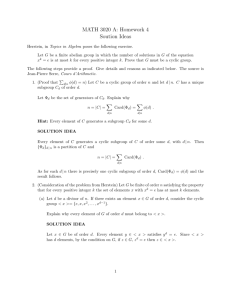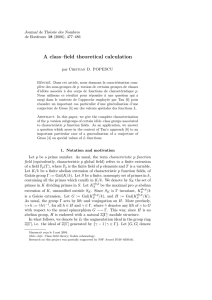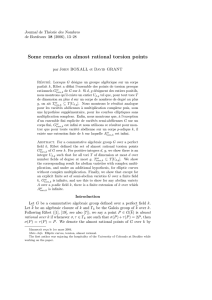A note on the torsion elements in the centralizer Karel Dekimpe 1
advertisement
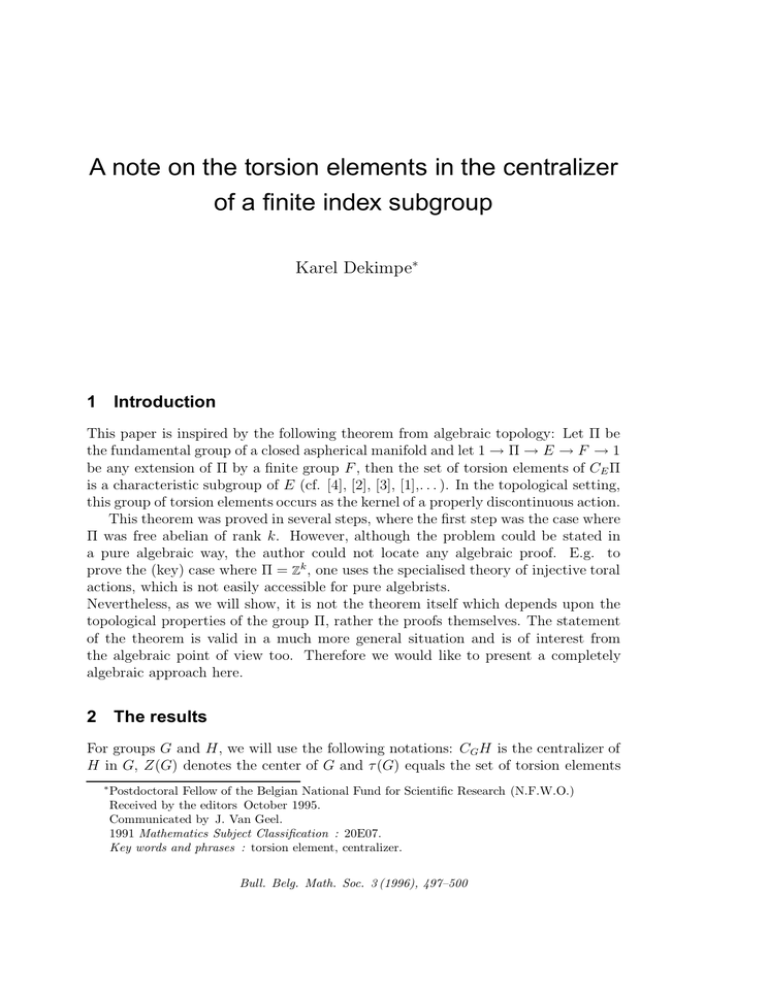
A note on the torsion elements in the centralizer
of a finite index subgroup
Karel Dekimpe∗
1 Introduction
This paper is inspired by the following theorem from algebraic topology: Let Π be
the fundamental group of a closed aspherical manifold and let 1 → Π → E → F → 1
be any extension of Π by a finite group F , then the set of torsion elements of CE Π
is a characteristic subgroup of E (cf. [4], [2], [3], [1],. . . ). In the topological setting,
this group of torsion elements occurs as the kernel of a properly discontinuous action.
This theorem was proved in several steps, where the first step was the case where
Π was free abelian of rank k. However, although the problem could be stated in
a pure algebraic way, the author could not locate any algebraic proof. E.g. to
prove the (key) case where Π = Zk , one uses the specialised theory of injective toral
actions, which is not easily accessible for pure algebrists.
Nevertheless, as we will show, it is not the theorem itself which depends upon the
topological properties of the group Π, rather the proofs themselves. The statement
of the theorem is valid in a much more general situation and is of interest from
the algebraic point of view too. Therefore we would like to present a completely
algebraic approach here.
2 The results
For groups G and H, we will use the following notations: CG H is the centralizer of
H in G, Z(G) denotes the center of G and τ (G) equals the set of torsion elements
∗
Postdoctoral Fellow of the Belgian National Fund for Scientific Research (N.F.W.O.)
Received by the editors October 1995.
Communicated by J. Van Geel.
1991 Mathematics Subject Classification : 20E07.
Key words and phrases : torsion element, centralizer.
Bull. Belg. Math. Soc. 3 (1996), 497–500
498
K. Dekimpe
in G.
Lemma 2.1
Let 1 → Zk → E → F → 1 be any central extension, where F is a finite group.
Then τ (E) is a characteristic subgroup of E.
Proof : Once we know that τ (E) is a group, it follows automatically that it is
characteristic. As E is a central extension of Zk by F , we may view E as being the
set Zk × F , where the multiplication ∗ is given by
(a, α) ∗ (b, β) = (a + b + c(α, β), αβ), ∀a, b ∈ Z , ∀α, β ∈ F,
(1)
for some 2–cocycle c : F × F → Zk . Since Qk is a vector space, the inclusion map
i : Zk → Qk induces a trivial map i∗ : H 2 (F, Zk ) → H 2 (F, Qk ) = 0 on the cohomology
level. This means that there is a split short exact sequence 1 → Qk → E 0 → F → 1,
where E 0 denotes the group determined by the cocycle i(c). (I.e. E 0 = Qk × F and
multiplication is given by (1), where a and b may now belong to Qk .)
So there is a splitting morphism s : F → E 0 . But it is now easy to see that s is
unique, since for all f ∈ F , s(f) has to be a torsion element and there is only one
torsion element in E 0 mapping to f. This shows that s(F ) = τ (E 0) and so τ (E 0) is
a group. The proof finishes, by realizing that E ⊂ E 0 and so τ (E) (⊆ τ (E 0 )) has to
be a group also.
Remark 2.2
1. The proof of the lemma might suggest that the group E can be decomposed
into a direct sum E = Zk ⊕ F 0 for some finite group F 0. However, this is not
true: consider the group E = (Z ⊕ Z 2)oZ2 where Z 2 = {0̄, 1̄} and the action
of Z 2 on Z ⊕ Z 2 is given by
1̄
(1, 0̄) = (1, 1̄) and 1̄ (0, 1̄) = (0, 1̄).
The group A = 2Z ⊆ E is indeed a free abelian, central subgroup of finite
index, so the conditions of the lemma are satisfied, but E cannot be seen as
the direct sum of a free abelian group and a finite one.
2. If we examine the conditions of the lemma we quickly see that the lemma is
false if we are not looking at central extensions (E.g. k = 1, F = Z 2 and
E = ZoZ 2 , where Z2 acts non trivially on Z) or at extensions of infinite index
(E.g. k = 0 and F = E = ZoZ2 ). However, as the following lemma shows,
there is no need for a free abelian kernel.
Lemma 2.3
Let A be any abelian group. If 1 → A → E → F is any central extension, where F
is finite, then τ (E) forms a chracteristic subgroup of E.
A note on the torsion elements in the centralizer of a finite index subgroup
499
Proof : τ (A) is a characteristic subgroup of A, and so there is an induced short exact
sequence
1 → A/τ (A) → E/τ (A) → F → 1.
From this it follows that it will suffice to prove the theorem in case A is torsion free
abelian.
Suppose A is torsion free and x, y ∈ τ (E). We have to show that xy ∈ τ (E). Let
E 0 denote the group generated by x and y, and A0 = A ∩ E 0. There is an induced
extension
1 → A0 → E 0 → F 0 → 1
where F 0 is some finite group. Since E 0 is finitely generated and F 0 is finite, we may
conclude that A0 is finitely generated too ([5, p. 117]). Therefore, we are in the
situation of lemma 2.1, which implies that τ (E 0) is a group, and so xy ∈ τ (E 0) ⊆
τ (E).
Theorem 2.4
Let E be any subgroup of finite index in a given group E 0 , then τ (CE 0 E) is a subgroup
of E 0 . Moreover, if E is torsion free and normal then τ (CE 0 E) is the unique maximal
normal torsion subgroup of E 0.
Proof : First, let us consider the case where E is normal in E 0. There is an exact
sequence of subgroups of E 0 :
1 → Z(E) → CE 0 E → F → 1
for some finite group F . It follows immediately from lemma 2.3, that τ (CE 0 E) is
a subgroup of E. It is normal in E, since it is characteristic in another normal
subgroup (CE 0 E). To proof the last statement it is enough to realize that, in case
E is torsion free, any normal subgroup T , containing only torsion, commutes with
E. Consider elements e ∈ E and t ∈ T , then we see that the commutator
[e, t] = e−1t−1 et = (e−1 ) (t−1 et) = (e−1t−1 e) (t)
| {z } | {z }
∈E
∈E
|
{z
∈T
} |{z}
∈T
belongs to E ∩ T = {1} which finishes the proof for E /E 0 .
If E is not normal in E 0 , we replace E 0 by the normalizer NE 0 E of E in E 0. Since
CE 0 E ⊆ NE 0 E we may apply the theorem for normal E to conclude the correctness
of the theorem in the general case too.
500
K. Dekimpe
References
[1] Dekimpe, K., Igodt, P., and Lee, K. B. Polynomial structures for nilpotent
groups. Trans. Amer. Math. Soc., 1996, 348, pp. 77–97.
[2] Lee, K. B. There are only finitely many infra-nilmanifolds under each nilmanifold. Quart. J. Math. Oxford (2), 1988, 39, pp. 61–66.
[3] Lee, K. B. Infra–solvmanifolds of type (R). Quart. J. Math. Oxford (2), 1995,
46, pp. 185–195.
[4] Lee, K. B. and Raymond, F. Topological, affine and isometric actions on flat
Riemannian manifolds. J. Differential geometry, 1981, 16 pp. 255–269.
[5] Passman, D. S. The Algebraic Structure of Group Rings. Pure and Applied
Math. John Wiley & Sons, Inc. New York, 1977.
Katholieke Universiteit Leuven, Campus Kortrijk,
B-8500 Kortrijk, Belgium




